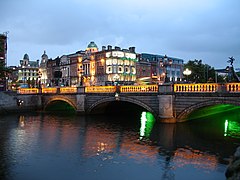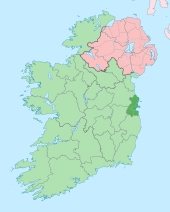County Dublin
| County Dublin Irish: Contae Bhaile Átha Cliath Republic of Ireland | |
 Dublin | |
|---|---|

| |
| [Interactive map] | |
| Province: | Leinster |
| Area: | 356 square miles |
| Population: | 1,187,176 |
| County seat: | Dublin |
The County of Dublin is a shire in the Province of Leinster, on the east coast of Ireland. It is the most populous county of the Republic of Ireland, containing as it does the City of Dublin and most of the conurbation of Greater Dublin. Its county town, at the heart of the county, is Dublin, the capital and largest town of the Irish Republic.
County Dublin is bounded by Meath to the north and north-west, County Kildare to the south-west and the mountains of County Wicklow to the south. It has been shaped more than anything by the city of Dublin and the trade and in past ages the settlers coming into that town.
County Dublin was one of the first of the parts of Ireland to be shired by King John in the century after the Norman invasion of Ireland. The population of the county is 1,270,603 according to the 2011 census, making it the most populous county in the country.
Landscape
County Dublin is generally a flat county, much formed by the broad valley of the River Liffey in its middle and the coastal plain, but from Dublin one may look south and see the dramatic Wicklow Mountains which trespass into the southern townlands of County Dublin. The only sizeable river in the county is the River Liffey.
The coast stretches for 70 miles, marked in the centre by Dublin Bay formed by the estuary of the Liffey and sheltered by the headland of Howth at its north. North and south of Dublin Bay and several lesser creeks and bays. Off-shore are islands, rare along the Irish east coast, the largest being Lambay and Ireland's Eye.
Inland the low, rolling countryside has prosperous farmland producing oats, and potatoes and grazing for cattle.
Though County Dublin is a heavily populated county in comparison to the rest of the Republic and industrialised, this is largely localised in Dublin itself and the neighbouring towns, such as Swords. The two major seaports of the county are Dublin and Dún Laoghaire.
History
Early history
In the 2nd century AD, Ptolemy identified Eblana (believed to be Dublin) as the capital of a people called the Eblani. In later centuries the territory north of the river Liffey was known as Mide or Midhe, which is to say "the Kingdom of Meath" (that to the south was known as Coigh Cuolan or Cualan). The west of this area was known as Teffia, and the east as Bregia (Latinized from Gaelic Magh Breagh, "the great plain of Meath"). Bregia comprised five triocha-cheds (equivalent to cantreds) or the later baronies, and was ruled by the King at Tara.[1] These princes, and various Gaelic chieftains, held sway over the area until the coming of the Vikings in the 8th century.
Vikings and Ostmen
By 841 AD, a Scandinavian settlement was established at Dublin. Initial settlement was troubled by bloody rivalry between the Danes and Norwegians and though the Danes had victory initially, it was the Norse who came to dominate the new Scandinavian colony. Norse were expelled from Dublin in 902, but they returned and re-established the city in 917, and it developed thereafter, much of the land of County Dublin being settled by Norsemen, who came to call themselves the "Ostmen". Norse Dublin was so established by the 11th century that it was regarded even amongst the surrounding native Irish as a kingdom amongst their own. The Norse Kingdom of Dublin stretched, at its greatest, from Drogheda to Arklow, and while mostly a thin strip of coastal land, from the Irish Sea westwards as far as Leixlip in the central part.
At the Battle of Clontarf on 23 April 1014 the High King Brian Boru defeated the Scandinavians on their own soil and thus curtailed the power of the Norse in Ireland, though the Kingdom of Dublin continued for over a hundred and fifty years, separate from the Irish Kingdoms though increasingly Hiberno-Norse. It gradually came under the influence of the Kings of Leinster: Diarmuid MacMurrough established himself in Dublin before his expulsion by the High King in 1166, a series of events which led to Strongbow's invasion in 1169 and the defeat of the last Norse King of Dublin, Hasculf Rognvaldsson, in 1171. Therafter, the lands around Dublin, which soon became the county, formed the heartland of English Ireland and of the area known as The Pale.
After the Anglo-Norman invasion
With the arrival of the Anglo-Normans in 1169, the lands which became County Dublin were ideal for settlement. Many of the Norse Ostmen left the city and crossed the river to found a new town, Oxmantown, now a suburb, while Dublin and the lands around it were developed by the new rulers.
The territory of the old Gaelic kingdom of Meath was granted in around 1172 to Hugh de Lacy by Henry II, King of England. Meath at that time included much of the northern part of the later county Dublin, part of the later county Kildare, and Delvin (in later Westmeath), while the city of Dublin remained under the King himself. Richard de Clare, 2nd Earl of Pembroke, known as "Strongbow" had led the first victorious campaign and he was permitted to remain a power in the land, which is evidenced by several grants which he made in his own name within the city to St Mary's Abbey and his foundation of a hospital of St John of Jerusalem at Kilmainham.
The royal demesne extended beyond the city itself to encompass much of the south of the county. Over half of the land in the county of Dublin was granted to religious houses and priories, as well as archbishops and monasteries, and minor lay lords. In such way too, an estate was given to the Irish chieftain MacGillamocholmog, who held sway over the territory of Cualann (Wicklow) when the English arrived.[2]
King John
In 1210, King John came to Ireland (a return after his less than successful period as Lord of Ireland under his father, Henry II). He established the county system for the administration of Ireland and County Dublin was one of the first twelve counties.[3]
Towns and villages


- City:
Major towns:
- Villages and Dublin suburbs:
Media
- The local radio stations include 98FM, FM104, 103.2 Dublin City FM, Dublin's Q102, Spin 1038, Dublin's Country Mix 106.8, Phantom FM|Phantom 105.2 and Radio Nova.
- The local newspapers include Dublin Penny Journal, The Echo, The Northside People, The Southside People, Liffey Champion and The Metro Herald.
- Most of the area can receive the five main British television channels on analogue television as well as the main Irish channels, along with Sky TV and UPC cable television.
Outside links
References
- ↑ See Annals of the Kingdom of Ireland, by the Four Masters (written 1632-1636 by a team of Franciscan scholars, led by Br Michael O’Clery, hereditary historian to the O'Donnell Kings and Princes of Tyrconnell, and based on records surviving from the earliest times; translated by John O’Donovan, ed., 1856, reprinted by De Burca Publishers, Dublin, 1998)
- ↑ The Environs of Dublin, by Francis Elrington Ball, M.R.I.A, in volume I of his History of the County of Dublin, (1902)
- ↑ A Topographical Dictionary of Ireland, Volume I, by Samuel Lewis, Published by S. Lewis & Co., London, 1837 (page 522)
Bibliography
- Rotuli Chartarum in Turri Londinensi Asservati, edited by Thomas Duffus Hardy, published in 1837. (Available in the Tower of London and in the Guildhall Library, London, it contains original text of the Grant of Fingal by King John in 1208).
- The Calendar of the Gormanston Register, Royal Society of Antiquaries of Ireland, edited by James Mills and M.J. McEnery, University Press, Dublin, 1916. The Gormanston Register is a collection of ancient manuscripts going back to the 12th century, belonging to the Viscounts Gormanston, and now lodged in the National Library of Ireland, in Dublin.
- History of the County of Dublin, by Francis Elrington Ball, Dublin, 1902.
- History of the County of Dublin, by John D'Alton, Esq., M.R.I.A. Hodges and Smith, Dublin, 1838.
- Dublin City and County: From Prehistory to Present, edited by F.H.A. Aalen and Kevin Whelan, Geography Publications, Dublin, 1992 [ISBN 0-906602-19-X].
- The Scandinavian Kingdom of Dublin, by Charles Haliday, edited by John P. Prendergast, published by Alex. Thom & Co., Printers and Publishers, Dublin, 1881
| Counties of the Republic of Ireland |
|---|
|
Carlow • Cavan • Clare • Cork • Donegal • Dublin • Galway • Kerry • Kildare • Kilkenny • Laois • Leitrim • Limerick • Longford • Louth • Mayo • Meath • Monaghan • Offaly • Roscommon • Sligo • Tipperary • Waterford • Westmeath • Wexford • Wicklow |